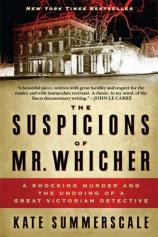Reading Group Guide
Discussion Questions
The Suspicions of Mr. Whicher

1. “This book is modelled on the country-house murder mystery, the form that the Road Hill case inspired, and uses some of the devices of detective fiction,” Summerscale writes in her introduction (xiii). How does the form ofThe Suspicions of Mr. Whicher complement its subject? What are some of the “devices” that Summerscale borrows from fiction?
2. Summerscale delves into the vocabulary of detection, from “coppers” (46) to “clue” (68) to “detect” (157). Which word origins were the most surprising and interesting, and why?
3. What role did privacy play in the Road Hill case? How did notions of privacy impede or advance the case? How do Victorian ideas of privacy and domesticity compare to today’s concept of the home?
4. Summerscale lists some of “Whicher’s detective qualities: an excellent memory, an eye for the incongruous, psychological acuity, and confidence” (50). Which of these qualities were apparent in Whicher’s investigation of the Road Hill murder? Which qualities seemed to fail him as the case unraveled?
5. Discuss the importance of class relations to the Road Hill case. What was the relationship between the Kent family and the villagers of Road? What were the sources of class tension between Whicher and the local police?
6. How was the Road Hill murder case a product of its time? What features of the Victorian era were especially prominent in the case? What was the influence of Charles Darwin’s emerging theories?
7. Summerscale observes an aspect that Whicher and Samuel Kent have in common: “Factory inspectors, like police inspectors, were agents of surveillance” (61). What is the significance of this similarity? Did Whicher and Kent seem aware of what their occupations have in common? Might Whicher have had a bias toward Kent? Why or why not?
8. What role did gender play in the case? How were the female suspects, Elizabeth Gough and Constance Kent, treated by the police, the press, and the public? How might the case have proceeded differently with a male primary suspect, such as Samuel Kent, William Kent, or a male servant?
9. “Whicher’s job was not just to find things out, but to put them in order. The real business of detection was the invention of a plot” (94). How does the chronology of The Suspicions of Mr. Whicher parallel the order of detection? When does Summerscale deviate from chronological order, and why?
10. “The Road Hill case was dense with fabric” (70). How did the material evidence shape or unravel the case? How would a murder investigation today handle these bits of fabric?
11. Summerscale recounts, “In the early 1860s the emotions aroused by the Road Hill murder went underground, leaving the pages of the press to reappear, disguised and intensified, in the pages of fiction” (217). What was the relationship between fiction and nonfiction in the Road Hill case? Which genre came closer to the truth of the murder and its motives?
12. To the public, Constance’s confession was a sign that “God had triumphed where man—and science, and detection—had failed” (236). What role did religion play in the unraveling of the Road Hill murder case? Why might the public have credited religion over detection in the resolution of the case?
13. Summerscale points out Constance Kent’s own “impulse to detect,” dating from her childhood (296). What did Constance and Whicher have in common? Where did their “detection” methods differ? In the end, how was Constance an “imperfect detective” (299)? Could the same label also be applied to Whicher? Why or why not?
14. Summerscale identifies a pitfall of investigation: “The danger, in a real murder case, was that the detective might fail to solve the crime he had been sent to investigate. He might instead get lost in the tangle of the past, mired in the mess he had dug up” (75). In the end, which secrets of the Kent family seem irrelevant to the murder?
15. William Kent is a shadowy figure for much of the book, emerging as a distinct personality mostly in Part Three. Why is so little recounted of William in the beginning? What aspects of his personality emerge as most interesting—and most suspicious—in the final pages of the book? Is Whicher’s accomplice theory the most plausible? Why or why not?
16. Summerscale writes of Saville Kent in her afterword, “In unravelling the story of his murder, I had forgotten him” (303). Is this forgetting apparent in the book? Is this work of nonfiction “a tragedy with a happy ending,” as Raymond Chandler deemed the detective story (304)? Why or why not?
17. Which recent murder cases have caused as great a sensation as the murder at Road Hill of 1860? Why might murder prove so riveting in the press and in fiction, both in the Victorian era and today?
Suggested reading
Kate Summerscale, The Queen of Whale Cay; Wilkie Collins, The Moonstone and The Woman in White; Charles Dickens, The Mystery of Edwin Drood and Bleak House; Elizabeth Mary Braddon, Lady Audley’s Secret; Sir Arthur Conan Doyle, The Adventures of Sherlock Holmes; Dashiell Hammett, The Maltese Falcon; Charlotte Brontë, Jane Eyre; Daniel Stashower, The Beautiful Cigar Girl; Caleb Carr, The Alienist; Erik Larson, The Devil in the White City.
The Suspicions of Mr. Whicher
- Publication Date: February 24, 2009
- Paperback: 400 pages
- Publisher: Walker & Company
- ISBN-10: 080271742X
- ISBN-13: 9780802717429







